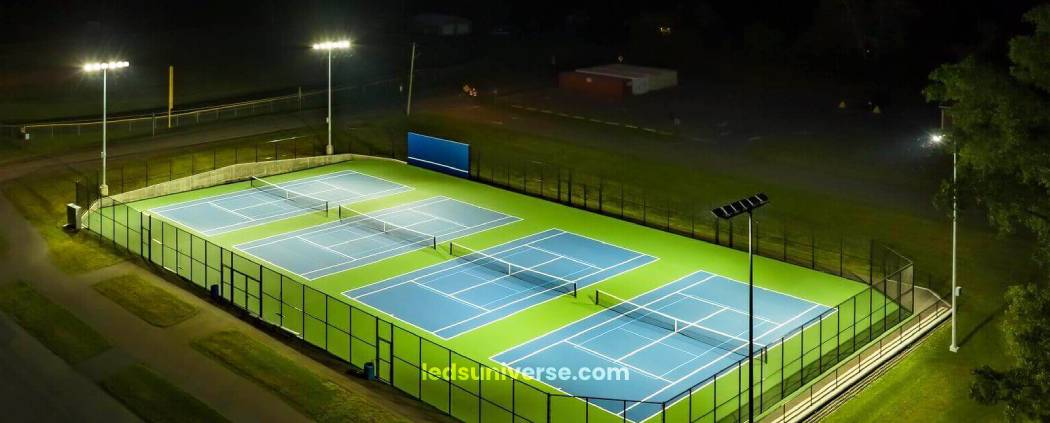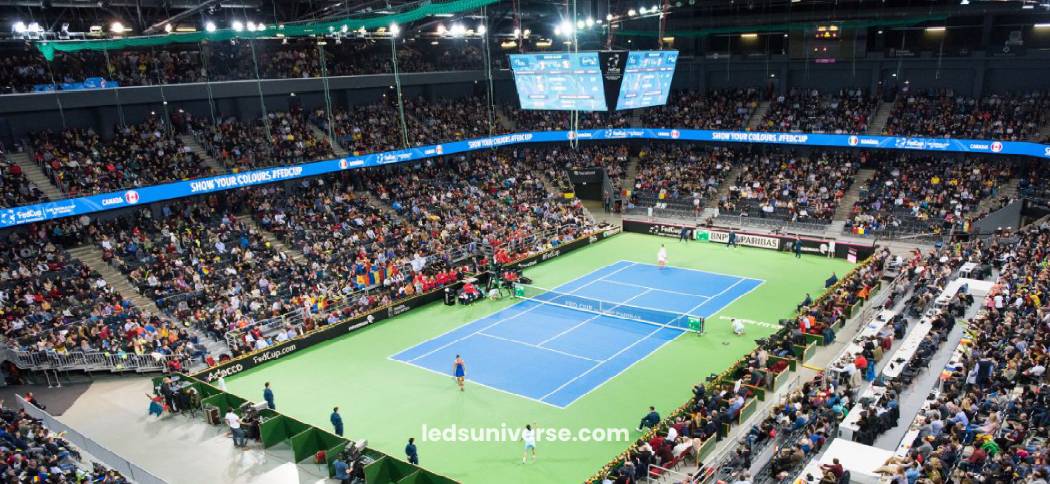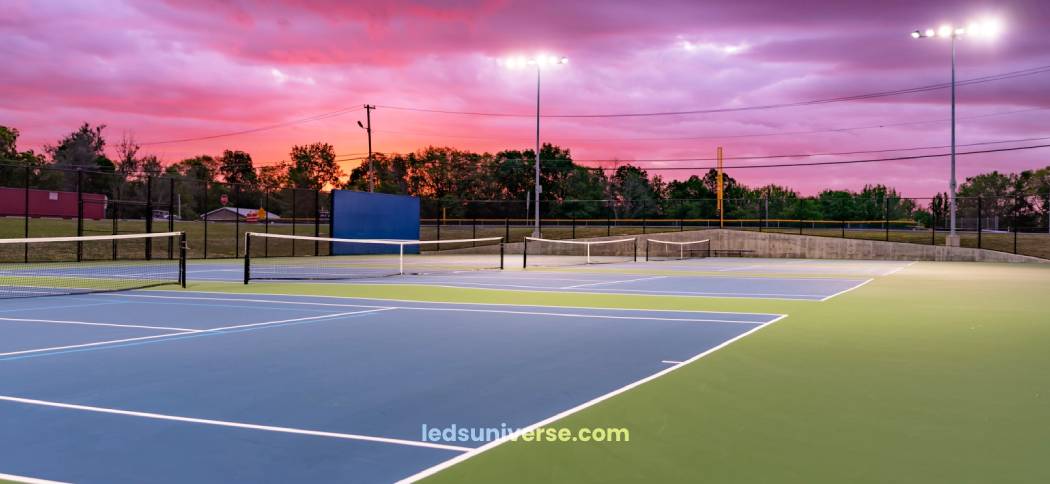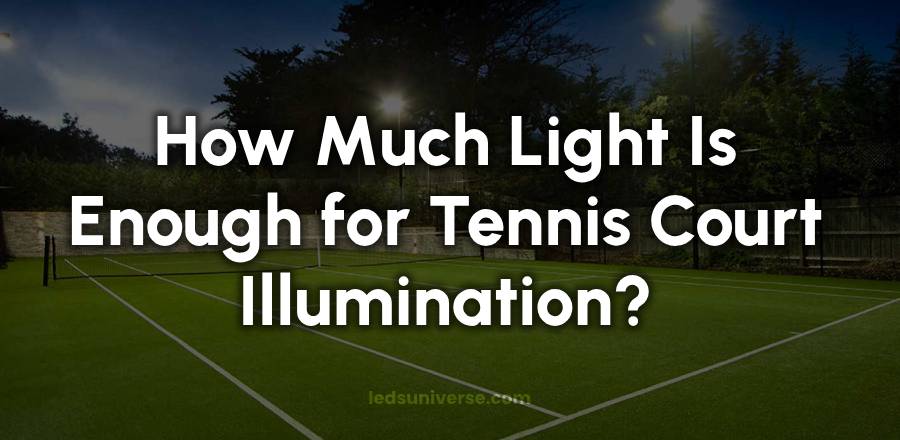Tennis is a sport that relies heavily on visibility, precision, and timing. Whether played during the day or night, the quality of lighting on a tennis court directly affects the game. For players to perform well and spectators to enjoy the match, proper illumination is vital. Understanding how many lux are required for various court settings helps design lighting systems that enhance playability and maintain visual comfort.
Table of Contents
ToggleUnderstanding Lux and Its Role in Lighting Design

Lux is a unit that measures the amount of light that falls on a surface. In the context of tennis courts, it refers to the intensity of illumination across the playing area. One lux equals one lumen per square meter. Lux values help lighting designers determine how bright a space will be, taking into account how light spreads and is distributed across the court.
Unlike wattage, which measures energy consumption, lux focuses on the effectiveness of lighting. The same light source can produce different lux levels depending on how it is directed and the distance from the surface. Proper lux levels ensure that players can see the ball clearly from all angles and that there are no harsh shadows or overly bright spots that cause discomfort.
Different Types of Tennis Courts and Their Lux Requirements
| Type of Court | Recommended Lux Range | Purpose/Usage |
|---|---|---|
| Recreational Courts | 200 – 300 lux | Leisure or casual play. Adequate for non-competitive play with focus on comfort and visibility. |
| Club and Training Facilities | 400 – 500 lux | Skill development and training. Ensures clarity and reduces eye strain during prolonged play. |
| Professional Courts | 1000 – 1500 lux | Competitive and broadcast-level play. Provides high visibility, eliminating shadows and flickering. |
| Broadcast-Level Courts (Major Tournaments) | 1500+ lux | For televised matches, ensuring sharp clarity and color accuracy for both players and cameras. |
Recreational Courts
For tennis courts used primarily for leisure or casual play, the lux requirements are generally lower than those used for professional competition. Recreational players need enough light to follow the ball and judge its trajectory effectively. A typical recommendation for this level of play is between 200 to 300 lux. This range provides adequate visibility, ensuring that players can see the ball clearly and maintain proper timing without excessive brightness that could lead to discomfort or unnecessary energy consumption.
The goal for recreational court lighting is to create an environment where players can enjoy the game comfortably while maintaining a pleasant visual experience. To achieve this, lighting fixtures should be positioned strategically to reduce glare, which could distract or impair the players’ vision, and to provide even distribution of light across the court surface. Shadows should be minimized, and lighting should be evenly spread to cover the entire playing area. While high-end, expensive fixtures are not always necessary for recreational courts, maintaining uniformity in illumination makes a noticeable difference in the overall quality of play and comfort. Even light distribution also contributes to reducing strain on the eyes during extended play sessions.
Club and Training Facilities

Courts that cater to clubs, academies, or training centers often require brighter and more evenly distributed lighting, as these environments focus on skill development and frequently experience high levels of use. These courts are typically used for both practice and competitive play, where clarity and precision are important. A lux level of 400 to 500 is commonly recommended for such settings. This range of lighting is bright enough to support fast-paced play, ensuring players can track the ball with ease, while also providing sufficient brightness for coaches to monitor players’ technique effectively.
Players in these settings often train during the evening or early morning hours, which places greater demand on artificial lighting systems. The lighting must provide clarity and minimize shadows, ensuring players can see the ball from any angle on the court. Higher lux levels reduce eye strain during intense play, which is especially beneficial for prolonged training sessions or high-energy practices. Furthermore, the use of video recording and analysis is a common practice in training environments, and bright, evenly distributed lighting helps capture sharp and detailed footage of players in motion. The lighting system must support such activities, enabling clear, high-quality visual recordings that coaches can review for further analysis and improvement.
Professional and Broadcast-Level Courts

Lighting requirements for professional courts are much higher due to the speed of the game and the need for clear visibility under all conditions. These courts are often used for competitive matches, including major tournaments and events that may be televised, where lighting quality directly impacts the viewing experience. Lux levels for these courts typically start at 1000 lux and can exceed 1500 lux, depending on the size of the venue and broadcasting standards. The goal is to ensure that the ball remains visible, even at high speeds, and that players are well-lit from all angles for both the audience and cameras.
In these settings, lighting must be precisely engineered to eliminate flicker, maintain uniformity, and avoid casting shadows that could disrupt play or obscure the ball’s movement. For broadcast-level courts, color rendering is also a consideration, as the lighting must reproduce colors accurately and provide a high-quality visual experience for both players and viewers. The quality of the broadcast depends heavily on the lighting system, as poor lighting can result in distorted images, flickering, or glare that distracts from the match.
Fixtures for professional courts are usually installed at high elevations, with carefully calculated beam angles and fixtures designed to distribute light evenly across the entire playing area. The lighting must be powerful enough to cover the entire court without creating distractions such as glare spots. Shadows are minimized through the strategic placement of lights and the use of diffusers or reflectors to direct the light precisely where it is needed. The installation and positioning of lights are also key factors to ensure the consistency of light levels across the court, contributing to the comfort of players and providing a professional, distraction-free experience for spectators and broadcasters alike.
Uniformity and Light Distribution
Having the correct lux level is only one part of creating a successful lighting setup. Uniformity is equally vital, as it ensures the entire playing surface is evenly lit. Poor distribution can result in bright patches and dark zones, which make it hard for players to track the ball. It can also affect depth perception and overall gameplay quality.
Uniformity ratios help evaluate how consistent the light levels are across a court. A good ratio ensures that no spot is significantly brighter or dimmer than another. For recreational courts, a uniformity ratio of 0.5 to 0.6 is common, while professional courts often require ratios above 0.7. Achieving high uniformity involves careful fixture placement, the use of advanced optics, and regular maintenance.
Impact of Surface Type on Lighting Needs
The type of court surface also influences lighting requirements. Hard courts tend to reflect more light, which can make lower lux levels feel brighter. Clay and grass courts, on the other hand, absorb more light and may require slightly higher lux values to achieve the same level of visual clarity.
Additionally, the texture and color of the court can influence how light is perceived. Darker surfaces absorb more light, while lighter ones reflect it. When designing lighting systems, these factors are taken into account to avoid over- or under-illumination. Customized lighting solutions help ensure consistent performance regardless of the playing surface.
Outdoor vs Indoor Tennis Court Lighting
Outdoor Courts

Outdoor courts present unique challenges due to environmental variables like moonlight, surrounding lights, and weather conditions. Lighting systems must be resilient to wind, rain, and temperature fluctuations. While natural light is beneficial during the day, nighttime play depends entirely on artificial sources. A recommended range of 300 to 500 lux works well for most outdoor recreational and club courts, with higher levels used for tournaments or televised events.
For outdoor recreational courts, the lighting should generally focus on comfort and playability. A lux range of 200 to 300 is sufficient for casual games, while club-level or competitive courts often require up to 500 lux. When preparing for televised events or major tournaments, lighting should be closer to 1000 lux or more, depending on the broadcast quality needed.
For higher-end outdoor tournaments, such as ATP or WTA events, lux values of 1200 to 1500 are recommended to ensure that players and the ball remain clearly visible for both participants and the audience. These setups are designed with strict guidelines to maintain consistent light distribution and ensure that there is no flickering or uneven lighting during critical moments of the match.
Pole height and fixture angles are critical to achieving even coverage. Lights must be installed high enough to prevent shadows but positioned to avoid glare. Shielding and directional reflectors help keep light on the court and minimize spillover into neighboring areas. For optimal results, poles should be positioned at a height of 9 to 12 meters, depending on the court’s size.
Indoor Courts
Indoor facilities benefit from controlled conditions, allowing for more predictable lighting results. However, ceilings and wall colors can influence how light behaves. Bright ceilings and walls reflect light and help boost overall illumination, while darker interiors absorb light and require higher output fixtures to compensate.
For indoor settings, lux levels can typically be lower than those required for outdoor courts, due to the absence of ambient light interference. A lux range of 400 to 800 is common, depending on the level of play and the space’s design. Glare control and uniformity remain top priorities in indoor setups to enhance comfort and visibility.
In recreational or club-level indoor courts, lux levels of 400 to 500 are usually sufficient for casual or competitive play. For professional-level indoor courts, however, the lighting requirements increase, often demanding lux levels closer to 800 to 1000 lux. Indoor lighting systems must be designed to eliminate any flickering and ensure smooth video capture for televised matches.
Fixtures installed indoors also have different considerations. The ceiling height, typically around 6 to 9 meters for most indoor tennis courts, plays a significant role in the type of fixtures used and their positioning. Proper beam angles and reflector designs help control the light spread and avoid uneven lighting across the court surface.
Energy Considerations and Technology Choices
Modern lighting technologies offer options that balance performance with energy efficiency. LED fixtures have become the preferred choice for tennis courts due to their long lifespan, consistent output, and reduced energy use. Compared to traditional metal halide or halogen lights, LEDs provide more controlled light distribution and better color accuracy.
Advanced lighting systems also include features like dimming, remote control, and automated schedules. These allow facilities to tailor lux levels based on the time of day or type of event. Sensors can be used to adjust output in real time, reducing costs and enhancing the user experience.
Investing in high-quality fixtures pays off in the long run through reduced maintenance and operating costs. Properly designed systems also improve safety for players and spectators, reducing the likelihood of accidents caused by poor visibility.
Compliance With Standards and Guidelines
Several organizations provide guidelines for tennis court lighting to promote consistency and safe playing environments. The International Tennis Federation (ITF) outlines standards based on court use, while local building codes and sports associations may add additional requirements.
These guidelines cover lux levels, uniformity ratios, glare limits, and color rendering. Following them ensures a balanced lighting system that supports fair play and meets player expectations. It also helps venues prepare for hosting competitive events that demand a higher level of lighting quality.
Designing a Lighting Plan for Optimal Illumination
Creating an effective lighting plan involves several stages, including site analysis, fixture selection, and layout design. Experts use simulation software to model how light will spread across the court, allowing adjustments before installation. Factors such as pole height, fixture angle, and court orientation all influence the final result.
Lighting plans also take into account surrounding infrastructure and environmental impact. Reducing light pollution and maintaining harmony with nearby residential areas is a consideration, particularly for outdoor courts. A well-planned lighting layout ensures that lux levels are met and maintained throughout the lifespan of the system.
Conclusion
The number of lux required for tennis court illumination depends on a variety of factors, including the court’s use, the level of play, and the location. Recreational courts may require as little as 200 lux, while professional venues demand over 1000 lux to meet broadcast standards. Regardless of the level, achieving uniform light distribution is a major consideration for creating the best possible playing conditions. Outdoor courts require more careful planning to account for environmental variables, while indoor courts benefit from a more controlled environment. By using modern LED technology and following established standards, facilities can achieve the right balance of energy efficiency and performance, ensuring a safe, enjoyable, and high-quality experience for players and spectators alike.
